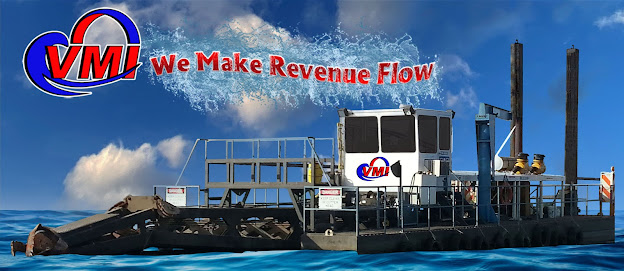- Get link
- X
- Other Apps
- Get link
- X
- Other Apps
Horizontal vs. Cutter Suction Dredges: Which One is Right for Your Project?
Dredging is a vital process for maintaining waterways, restoring environments, and supporting industries ranging from mining to municipal water treatment. But when it comes to selecting the right dredging equipment, the choice between a horizontal dredge and a cutter suction dredge (CSD) can make all the difference.
Both types of dredges offer unique advantages depending on the project’s needs, the type of sediment being removed, and the working conditions. In this guide, we’ll break down the key differences between horizontal dredges and cutter suction dredges, helping you determine which is best for your operation.
What is a Horizontal Dredge?
A horizontal dredge is a type of dredging equipment that utilizes an auger head to break up and pump sediment. These dredges are typically mounted on a floating platform and use a hydraulic system to control the auger and pump.
Key Features of Horizontal Dredges:
Auger Head Technology: Uses a rotating auger to agitate and remove sediment.
Precision & Low Turbidity: Designed for targeted sediment removal with minimal water disturbance.
Self-Contained & Easy to Operate: Can often be operated by a single person.
Shallow Water Capability: Ideal for small lakes, ponds, wastewater lagoons, and industrial settling basins.
Best Applications for Horizontal Dredges:
Municipal & Industrial Water Treatment: Used for dredging sludge in wastewater treatment plants.
Lakes & Ponds: Perfect for environmental restoration projects requiring precision.
Marinas & Canals: Effective for maintaining navigable depths in confined areas.
Ash Ponds & Mining Sediment Removal: Great for controlled excavation and fine material recovery.
Advantages of Horizontal Dredges:
Minimal Environmental Disruption: Reduces turbidity and prevents excessive sediment resuspension.
Compact & Maneuverable: Can operate in confined areas where larger dredges cannot.
Lower Operating Costs: Requires less fuel and fewer operators compared to larger dredging systems.
Ideal for Soft Sediment: Works well with materials like silt, sludge, and fine sediment.
What is a Cutter Suction Dredge (CSD)?
A cutter suction dredge (CSD) is a more powerful dredging system that uses a rotating cutter head to break up hard-packed materials before pumping them through a pipeline. These dredges are commonly used for large-scale excavation and channel maintenance.
Key Features of Cutter Suction Dredges:
Cutter Head Technology: Uses a rotating cutter to break up compacted or consolidated sediments.
High Production Capacity: Capable of moving large volumes of material quickly.
Versatile Applications: Can be used for sand, clay, gravel, and harder materials.
Pipeline Discharge System: Pumps dredged material to a designated disposal or processing site.
Best Applications for Cutter Suction Dredges:
River & Harbor Maintenance: Keeps navigation channels clear and functional.
Port & Coastal Dredging: Used for deepening and expanding harbors and waterways.
Land Reclamation & Beach Nourishment: Moves large amounts of sediment for construction projects.
Mining & Aggregates: Excavates sand, gravel, and other valuable materials.
Advantages of Cutter Suction Dredges:
Handles Tougher Sediments: Effective for harder materials, including clay and compacted sands.
Higher Production Rates: Moves more material per hour than horizontal dredges.
Longer Discharge Distance: Can transport dredged material further via pipeline.
Essential for Navigation Projects: Keeps critical waterways open for commercial and recreational use.
Making the Right Choice
Choose a Horizontal Dredge If…
Your project requires precision sediment removal (wastewater, ponds, canals).
You need minimal environmental disruption (low turbidity).
Your dredging site is shallow or confined (lagoons, industrial basins).
You’re working with soft, fine sediment (silt, sludge).
Choose a Cutter Suction Dredge If…
You need to move large amounts of material quickly (harbors, rivers, mining).
Your project involves hard-packed or compacted sediment (clay, gravel).
You require deepwater dredging capabilities (ports, coastal restoration).
Your dredged material needs to be transported long distances (pipeline discharge).
Get the Right Dredge for the Job
Both horizontal dredges and cutter suction dredges are powerful tools—but selecting the right one is essential for efficiency, cost savings, and project success
At VMI Dredges, we manufacture high-performance horizontal and cutter suction dredges designed for a wide range of applications. Our team of dredging experts can help you find the perfect equipment for your project needs.
Ready to find the right dredge? Contact us today!
Pat Sumpter, Sales Manager, 918-225-7000, Ext. 12
www.vmidredges.com • sales@vmi-dredges.com
Dredge Manufacturer
dredge manufacturing
Dredge Rentals
Dredge Sales
Horizontal Dredges
Horizontal Mini-Dredge
This Is How You Dredge
We Make Revenue Flow
- Get link
- X
- Other Apps





Comments
Post a Comment